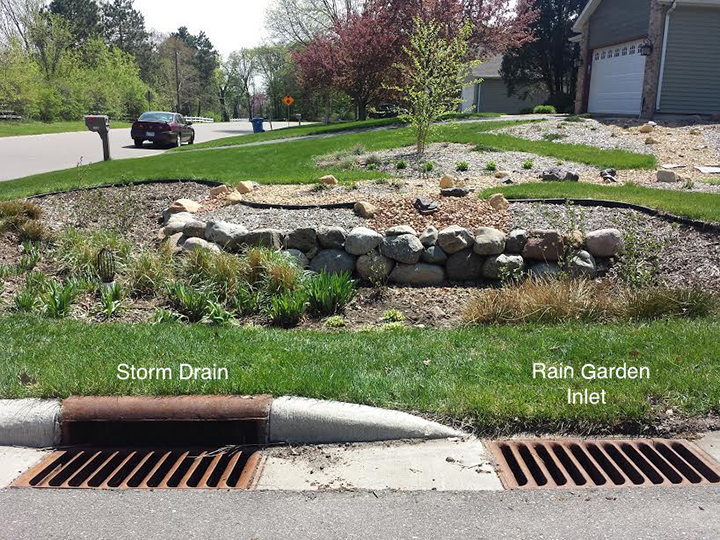Rain gardens in the metro


A residential rain garden in Woodbury, Minn.
By Gaby Gerken
One of the largest problems in urban areas is dealing with stormwater. The excessive amount of concrete in urban areas means that water is unable to flow directly into the ground. In fact, even your front lawn will produce runoff because the dense grass and root systems do not allow for much water to actually soak in. Because of this we have storm drains that direct water out of the streets and out of sight as quickly as possible.
At first glance this look like a great solution – cars and people can continue on their way without being stopped in their tracks by puddles and streams. The problem is that when the water drains off the street it picks up oil, dirt, soap and other chemicals as it flows to the storm drain. This causes pollution in the streams and lakes where the drains eventually flow.
Phosphorus and nitrogen are the most common chemicals found in the stormwater runoff and when they flow into a body of water they create huge algae blooms that can clog boat propellers, create a toxic swimming environment and lower oxygen levels in the water, making it difficult for fish to survive. Another problem is that the sediment can clog waterways and make it tough for aquatic species to grow. Fish and waterfowl depend on this for food.
This is where rain gardens and the Metro Roving crew come into play.
A rain garden is simply a garden that includes a depression to catch rainwater runoff from yards and streets. Rain garden plants are chosen to succeed during partial flooding and the garden provides homeowners with a unique landscape that can soak up rain and slow stormwater flow, remove pollutants and prevent erosion.
In recent years, Washington County Conservation District has been working with homeowners to install rain gardens in their front lawns. The District pays for the installation and maintains the gardens for a few years until they become established. Metro Roving has been taking care of this maintenance for the past few weeks and Corps crews will continue to visit the same gardens throughout the summer. This means driving through neighborhoods, finding the gardens and ensuring that they are weeded and working properly. Sometimes the inlets need to be fixed and cleaned or some areas have eroded and need extra dirt or sod. The last step is adding a few more inches of mulch. In the end, the gardens look beautiful and we leave knowing that we are helping a neighborhood and the watershed.
Since we have been working in the city we haven’t been seeing much wildlife, so this month’s list includes a few plants and shrubs we’ve learned about.
Plants spotted: Milkweed, Karl Foerster’s, sedge, turtlehead, Canadian thistle, purple coneflower, rattlesnake master, catnip, iris, sage, black-eyed Susan, dandelion, mustard, river birch, dogwood, snowberry.

Dump No Waste/ Drains To Fresh Water; a film of oil on the inlet.